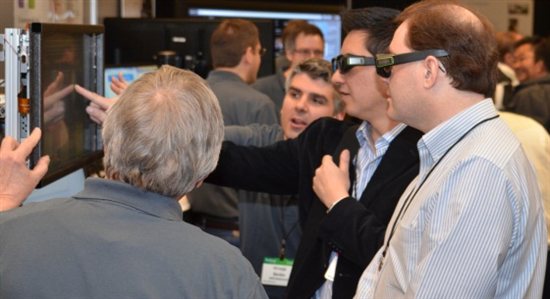One theme that really stood out today is the use of 3-D—typically to scan physical objects and transform them into three-dimensional models on your computer. So one project that really stands out—both literally and figuratively—is the 3-D display with haptic feedback that Mike Sinclair, Michael Pahud and Hrvoje Benko developed in cooperation with the Microsoft Research Engineering Lab.
Haptic feedback has always been a keen area of interest for Mike, and he’s also been heavily involved in the First Robotics Competition. This project combines the two disciplines into a 3-D display experience that adds the sense of touch. The standard display monitor has been retrofitted with resistance transducers that sense the amount of pressure a person is placing on the screen.
The transducers work in conjunction with a one-dimensional robot that looks a bit like those articulated television mounts that extends and pivots the television away from the wall. The robot responds to the sensory data generated by the pressure of your finger tip and moves forward or backward accordingly.
To explore the different dynamics that come into play, the team developed a simple game in which the user pushes against a variety of objects made up of different materials: a concrete cube, a wood cube, a sponge cube, a beach ball and the ubiquitous recyclable Microsoft coffee cup.
The team also touched on how doctors could use haptic feedback to virtually navigate a patient’s brain scan and identify where treatment is needed. There’s clearly a lot of technical and practical wizardry at play here, and judging from the number of people queuing up, there’s also a great deal of curiosity about where it could lead.
Check out the TechFest 2013 microsite for more information about the research projects on display.




